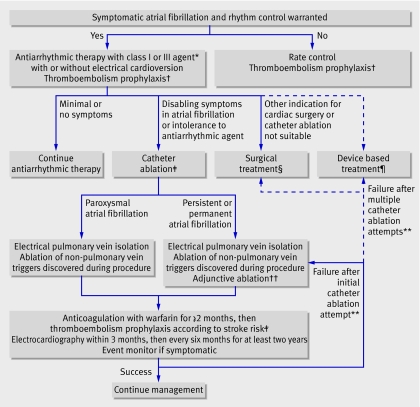Fig 5 Proposed algorithm for management of symptomatic patients with atrial fibrillation referred for rhythm control. Solid lines represent established pathways supported by clinical evidence, guidelines, or expert consensus documents. Dashed lines represent less established pathways. *Appropriate antiarrhythmic drug therapy is outlined in practice guidelines.1 †Underlying stroke risk can be assessed using the CHADS2 score21; one point each is assigned for a history of heart failure, hypertension, age >75, diabetes mellitus, and two points for previous cerebral ischaemia. Aspirin is generally recommended if the score is 0, aspirin or warfarin if the score is 1, and warfarin if the score is ≥2.1 ‡First line therapy with catheter ablation may be appropriate for patients in whom long term antiarrhythmic drug therapy may be harmful or for those who want to avoid antiarrhythmic drugs. Presence of a left atrial thrombus is an absolute contraindication to catheter ablation. §Summary of surgical techniques for restoration of atrial fibrillation can be found in Heart Rhythm Society consensus document.20 ¶Potential measures include permanent pacing or implantable atrial defibrillators for restoration of sinus rhythm.1 **Repeat catheter ablations should generally be delayed until at least three months after the initial procedure. No consensus exists on what constitutes the maximum number for repeat attempts. ††Substrate ablation in form of linear ablation, or ablation of complex fractionated electrograms or sites of autonomic innervation. Adjunctive ablation may be appropriate in patients with paroxysmal atrial fibrillation in whom an initial attempt has been unsuccessful

An official website of the United States government
Here's how you know
Official websites use .gov
A
.gov website belongs to an official
government organization in the United States.
Secure .gov websites use HTTPS
A lock (
) or https:// means you've safely
connected to the .gov website. Share sensitive
information only on official, secure websites.
